4.7 million people blog on a regular basis.
Thinking about becoming one?
Great. But you need to know a few things before you start, kid.
Content writing is one of the best ways to generate leads or make a living depending on why you’re doing it in the first place.
It’s easy to think you could crack your knuckles, begin typing, and become the next Neil Patel, but it just isn’t gonna happen.
Content writing takes practice and skill like anything else.
Heck, I’ve been content writing for 8+ years and feel like I’ve only gotten really good in the past year or so.
That’s why I’m going to share my best 15 content writing tips.
Use these next time you write content and you’ll notice a massive difference in quality and workflow.
1. Begin with the end in mind
We’ve all been there as writers.
You’re staring at a blank screen waiting for an idea to come up and before you know it, 30 minutes have passed and you haven’t written anything.
That used to be me.
After a while, I knew that something had to change.
I was wasting time and it was demotivating.
That’s precisely why I began planning out every article before-hand.
It’s easily one of the most transformative things I’ve learned as a writer.
The general concept is this: create a skeleton of the content you’re writing, including the headers, sub-headers, resources, and any ideas you have.
It’s as simple as that!
This can literally take a few minutes but save you hours of work later.
Let’s say that you’re writing a blog post on startup marketing. You can create an outline that looks something like this:
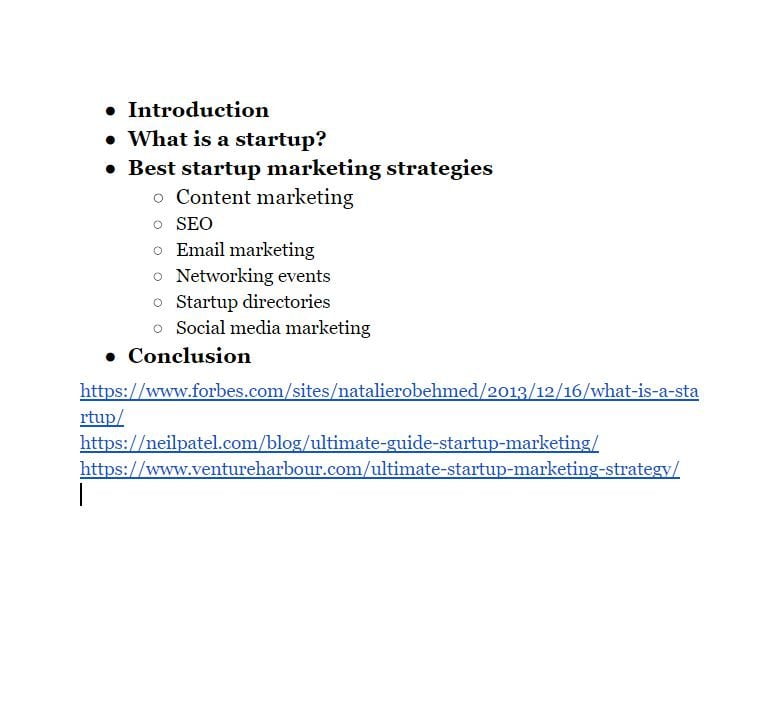
When you go to write the article, you already know exactly what to write about next so you aren’t left hanging.
This speeds up the workflow and it’s very motivating to see the word count rack up like a pinball score.
That also brings me to my next point.
2. Always do keyword research before you write
Content needs to educate. It needs to entertain. But it can’t do any of these things if people don’t find it first.
That’s why SEO is absolutely mandatory for any content writer.
In fact, Google changed their algorthim 13 times in 2017 alone.
If you don’t stay up to date on SEO, you’ll get left behind in the dust.
You don’t have to the inventor of the internet to be awesome at search engine optimization, either.
Understanding the fundamentals will set you ahead of many writers, helping you rank on the first page of Google and drive mountains of traffic.
I’ll be showing you how to perform on-page SEO for content in a moment, but keyword research is perhaps more important.
Keywords are phrases that users type into search engines to find a specific resource.
By using free keyword research tools, you can find relevant phrases to use strategically in your content.
This will help you rank for those terms and drive high-quality traffic through your articles.
I recommend that you perform keyword research before writing any content so you know exactly what terms to include as you begin.
Use a tool like SearchVolume.io to find search volume for keywords you’re interested in using.
Enter terms, separated by lines, into the box and click the submit button afterward.

This will display the search volume for each keyword below.

I always recommend that you should target a mix of low, medium, and high competition keywords.
Here’s why…
Low competitions phrases are like those apples on Grandma’s tree in her back yard: low hanging fruit.
Anyone can rank for them with good enough content and it helps build trust with Google while creating momentum.
The medium and high competition terms will take a lot more effort and time, but eventually, you can be ranking for them, too.
But what if you need inspiration for keywords? Head over to Google and play the “alphabet soup” game in that case.
Type in a keyword followed by each letter of the alphabet and the autosuggestion feature will give you more inspiration than seeing the Mona Lisa.
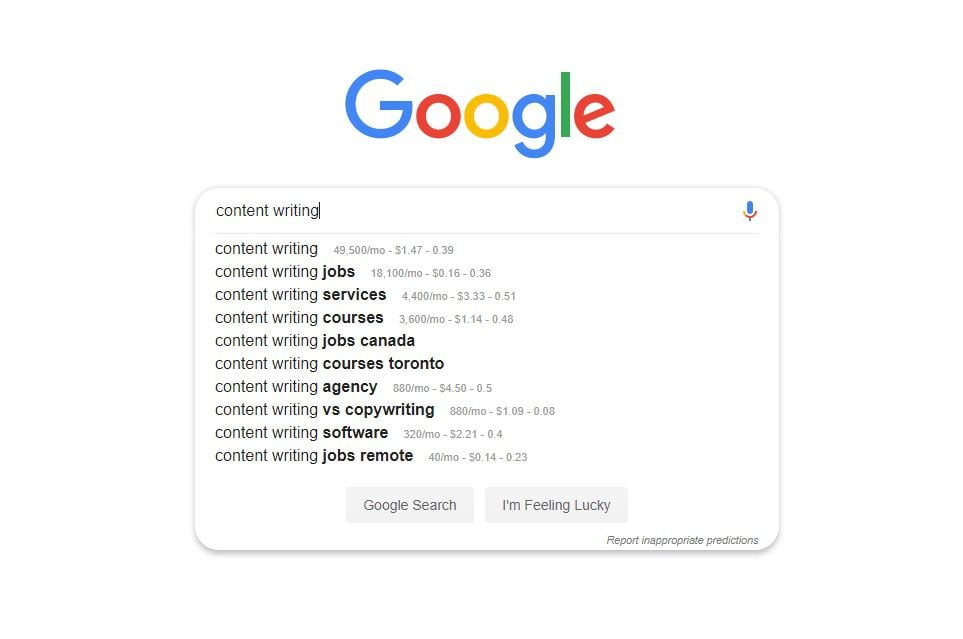
I have the free Google Chrome extension called Keywords Everywhere installed which displays extra metrics as you can see in the above image.
Read my review of it to learn how to install it and use it for massive SEO benefits.
Once you have a list of keywords, you’re probably going to think “What the heck do I do with them?” and that’s why I’ll be covering next.
3. Have an on-page SEO blueprint
Every piece of content you produce needs to be cleaner than a waxed floor.
Messy content doesn’t rank and irritates users because it’s disorganized.
This is precisely why every content writer needs to create an SEO blueprint they can apply to every blog post they write.
It will save you time, energy, and helps boost rankings in the SERPs consistently.
Let’s first talk about keywords. All of those search terms you researched earlier need to be placed and used in the following ways:
- URL: Add the main keyword you’re targetting to the URL of the blog post. Presuming you’re on WordPress, click the edit button by the URL at the top of the page to change it.
- Headline: The title of the article itself needs to include the main keyword you’re targetting if possible. Some times it may need to be a variation to sound natural and smooth.
- Title tag: The title tag is the title of the browser page and seen on the search engine results page. This helps both users and Google understand what the page is about, so include a keyword here, too.
- Meta description: While adding keywords to meta descriptions doesn’t directly boost rankings, it can increase click-through rates as they become bolded when searched for.
- Body of content: Keywords, secondary keywords, and variations need to be placed throughout the body of articles naturally and sparingly. Don’t stuff keywords like a calzone because Google is smarter than that, and you can get penalized.
- Header tags: Both search engine spiders and users scan headers to find key points of content, so adding keywords in H1, H2, and H3 tags are very effective for increasing rankings.
- Alt text and file names: Search engine spiders crawl everything. And I mean everything. So, it shouldn’t be a surprise that they look at file names and the alt text of media. Ensure that you optimize these two aspects of images and videos to include a keyword if it makes sense.
Follow those steps every time you write content and search engines will be able to more easily index you for target search terms.
Next, formatting is another thing you should add to your SEO blueprint.
Google likes content that is organized via headers, lists, and bullet points. Make sure to make these elements a part of every article you publish.
Set a specific word count to hit for every blog post, too. Search engines favor long form content since it packs more value and information.
I’d also recommend deciding on a certain amount of images and videos to include in each piece of content.
Having all of these aspects planned out ahead of time allows writers to templatize their content which is extremely efficient.
4. Integrate lead magnets into content
Lead magnets aren’t magnets you put on your fridge.
They are free resources you offer in exchange for a user’s personal information.
You can then get push them through your sales funnel to convert them into a paying customer later.
Lead magnets are normally e-books, cheat sheets, whitepapers, and case studies. Check out my guide to lead magnets to learn how to maximize the ROI of using them.
Once you have a lead magnet created, it’s effective to integrate directly into content.
This means offering the lead magnet in the middle or at the end of an article. Marketers tend to do this with checklists and cheat sheets because you can create one for each piece of content.
Heck, simply proposing your email newsletter works too like Keap does in their blog posts:
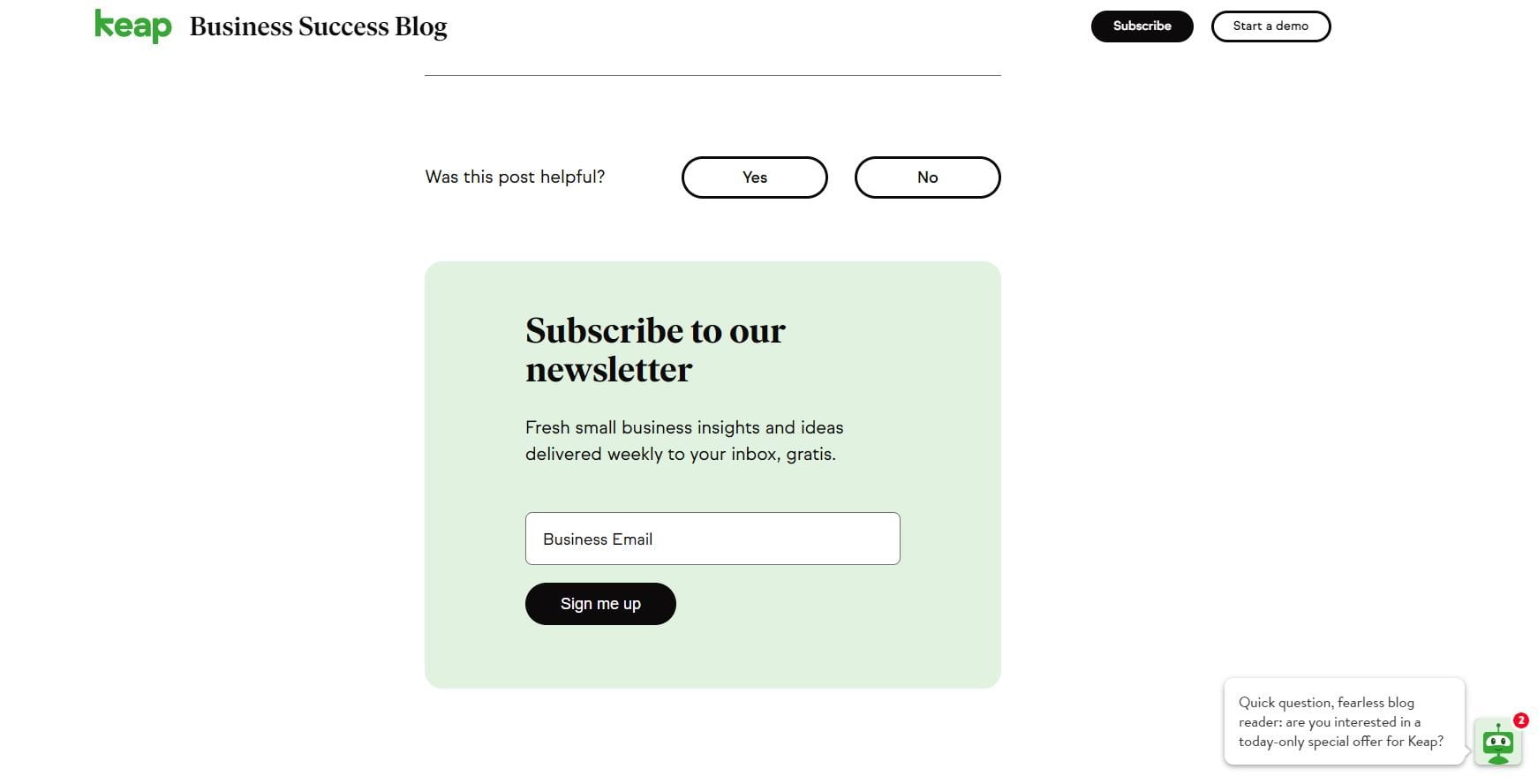
Content is supposed to generate results at the end of the day, right?
So, it only makes sense to maximize how many leads free resources create for you or clients by promoting them more aggresively.
5. Longer is better for most niches
Word count is important. Very important.
It’s all too easy to write 500 words, kick your feet up, and think the organic traffic is going to come in crashing like a tsunami.
Nope.
It’s been found that the average #1 result on Google is 1,890 words long. That’s a lot!
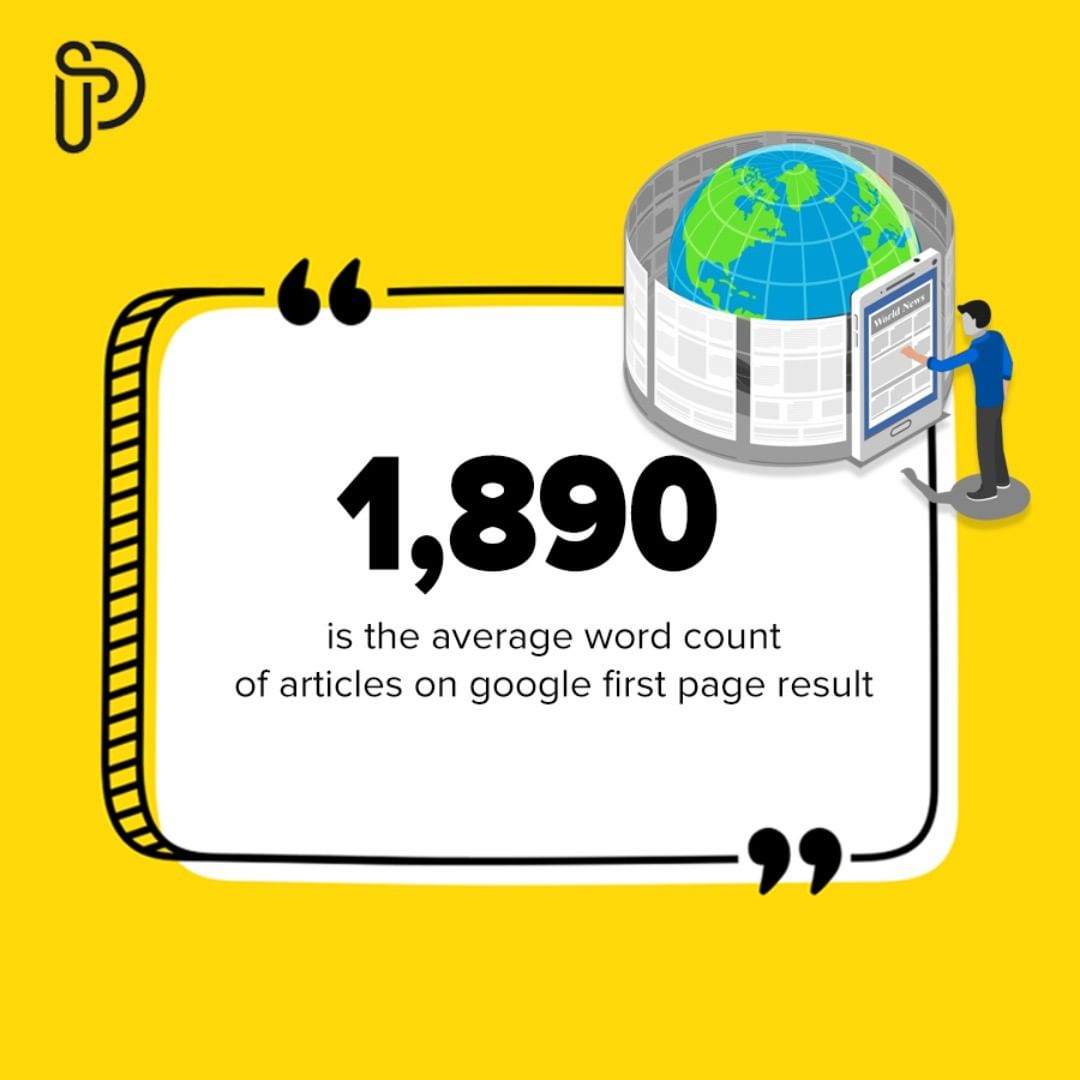
But it makes sense, too.
Long form content provides more information and resources for readers.
And what’s Google’s ultimate goal? To provide the best results for users.
If more people continue to use Google, they keep stacking that paper from advertisers.
That’s why you need to ensure that you never write less than 1,500 to 2,000 words for each article.
While some niches can get away with shorter content, like news sites, most will need to produce a higher word count.
There are heaps of benefits for doing so, such as:
- It helps your brand appear as an authority and thought leader.
- Long form content attracts more natural backlinks and social shares.
- You will be able to rank for more keywords, further increasing the organic traffic you generate.
If you follow the first content writing best practice I mentioned, which is planning out each piece of content, creating long articles isn’t hard.
It is time consuming, though. So, don’t be afraid to spend many hours writing because that’s simply what it takes.
Check out this video by the guys at Income School. They put it best: think of writing a short blog post under every header.
If you plan out 10 different points you’d like to cover in an article and write 200 words under each one, there are your 2,000 words!
This also ties into the next idea I have…
6. Make it practical and actionable
How many times have you been in this situation…
You use Google to find an answer to a question.
You click the first link.
The article sucks. It’s just blocks of text and doesn’t explain how to do anything.
Unfortunately, this happens way too often.
It’s also exactly why you can stand out from the crowd by making content actionable and practical.
That means providing the steps, tools, and resources to help the reader complete what they’re after.
You can achieve this by adding one of the following, or a combination, under each point you make within a piece of content:
- An interesting statistic that backs up your ideas.
- Charts or graphs.
- A case study proving what you’re speaking about.
- A tool and step-by-step instructions on using it.
- Exercises the reader can perform to become better at the subject.
Doing this takes your everyday, bland, boring blog post and transforms it into a masterpiece like a butterfly emerging from a cocoon.
Try it yourself and watch your readers itch to come back for more.
7. Sound like the reader’s best friend
The voice and tone you use in content is huge.
If the vocabulary and voice don’t match with the reader, they won’t be as likely to resonate with it or stick around.
That’s why a friendly and casual tone is universally effective.
You can speak to any audience, no matter if their beginners or experts on a topic, and they will enjoy it.
I really look up to people like Neil Patel and Brian Dean for this approach.
If you read their content, it feels like your friend is explaining how to do something.
Technical jargon is usually left out, sentences are short, and there’s a lot of casual aspects like puns and stories.
It also feels human.
Next time you’re writing up an article, type as you speak.
This means you shouldn’t be afraid to break some grammar rules. I do it all of the time and I write for a living 😉
You will notice that your sentences are more fun, choppy, and organic. They don’t sound forced and overly edited.
8. Spice up content with gifs
Articles aren’t newspapers.
That means they shouldn’t be walls of text or readers are going to bounce like they’re on a trampoline.
And what’s the best way to avoid walls of text?
Visuals. And more specifically gifs.
I love using gifs and memes because they sum up ideas and potentiate points you make.
They also just make content plain more entertaining and fun.
Memes are practically a language at this point too.
You see a meme and instantly know the meaning and concept behind it.
Pull up a website like Giphy when you’re writing and search for a gif related to the article.
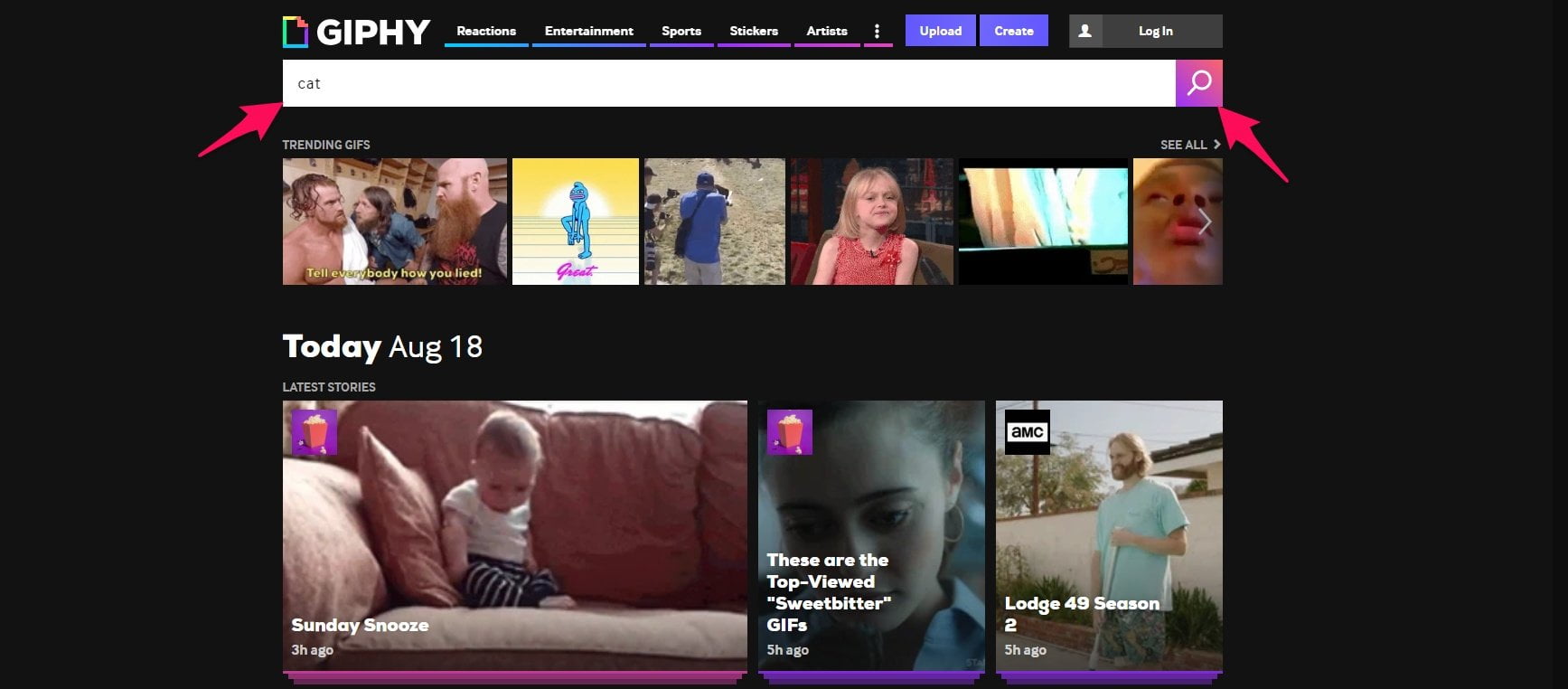
Click the embed button, copy the code it gives you, and paste it onto your website.
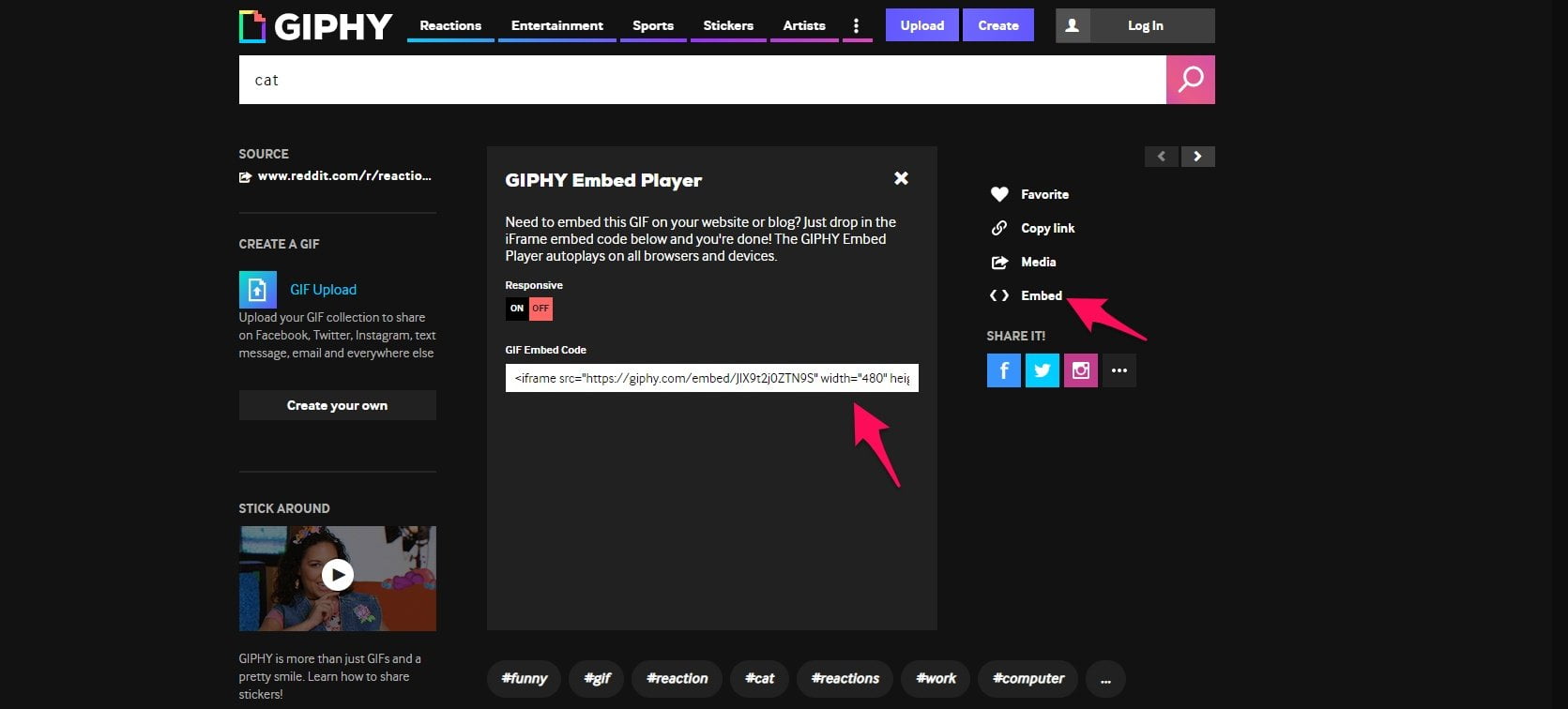
This will directly embed the gif which is often better than saving it and using up more website resources.
9. Plan out a content calendar for each month
So, you’ve begun planning out each piece of content and you feel like a million bucks.
But it’s also amazing to plan out content for the entire month.
This is what we call a content calendar.
It’s, as you could guess, a calendar containing all of your company’s content for the month.
Normally it includes topics, keywords, word count goals, and other notes.
Here’s a content calendar template for inspiration:
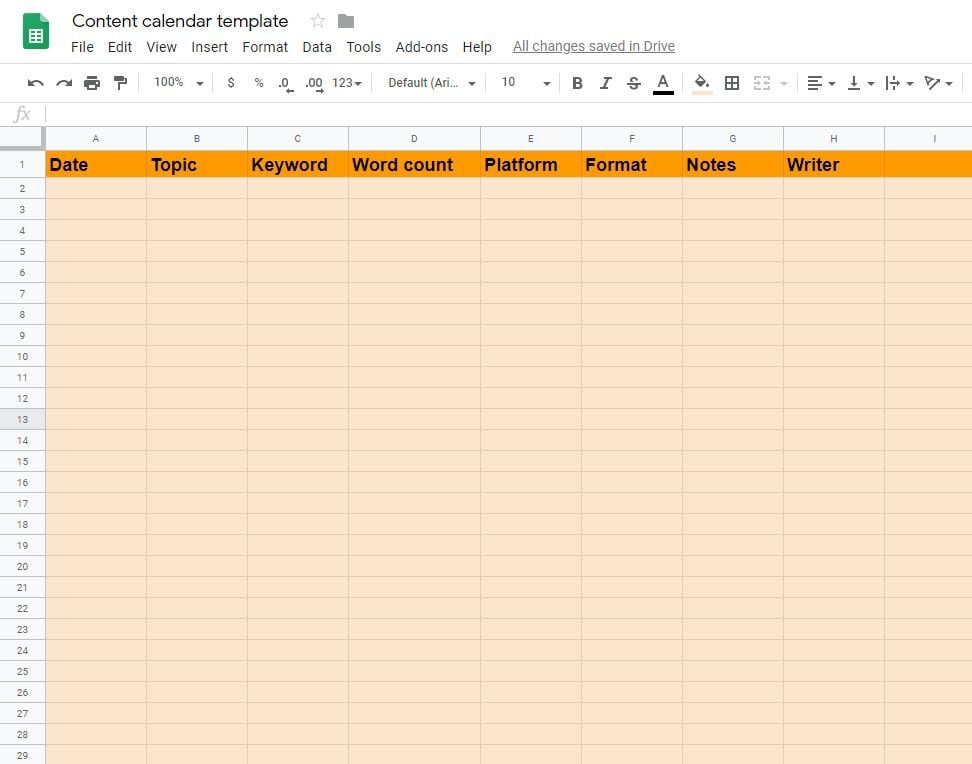
Actually, you know what? Here’s the Google Drive Link. Just click “File” and copy it to fill it out 🙂 My treat.
Content calendars have the same benefit of creating an outline for each article: it saves you incredible amounts of time and energy.
10. A consistent schedule is crucial for success
60% of markters are publishing a single piece of content each day. Are you?
If you want to see the most organic traffic and keep a consistent readership, you will need to publish content on a regular basis.
This allows your readers to tune in at a specific time and it also creates the compound effect.
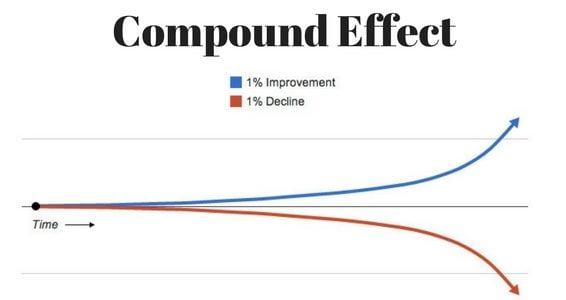
Imagine if you wrote three articles per week for an entire year.
That’d be 156!
You’d be ranking for thousands of keywords and be a mini-authority at that point.
Choose a schedule that works for your business and goals. It might be once per week, three times per week, or every day.
11. Don’t neglect the editing process
After you’ve written a piece of content, it’s easy to wipe your brow and think your job is done.
However, it’s now time to edit.
This is where you will clean up any mistakes you made, add more information, and reorder the points you made.
The goal of editing is to make the content easier to consume and as useful as possible to the reader.
That’s why I love using the Grammarly Google Chrome extension.
It connects to Google Drive, WordPress, and other platforms to help you edit on the fly.
Navigate to the Google Web Store page and install it to begin.
Then, navigate to your content and you will see recommendations from Grammarly.
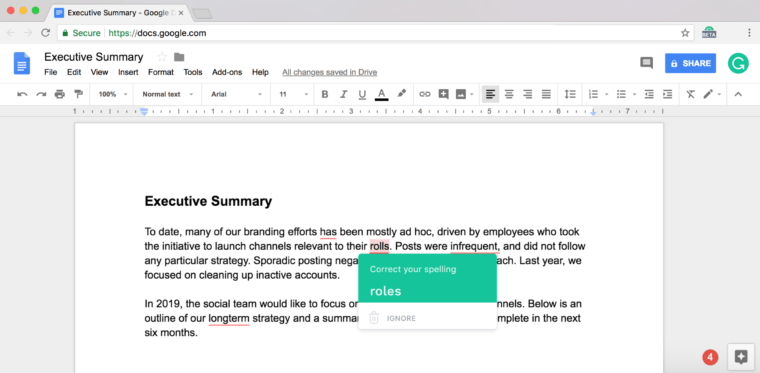
Use these to fix grammar and spelling mistakes, making your content more eligble and higher quality.
12. Use data and stats to back up points
Look at any of the most viral content on the internet.
I’m talking about Neil Patel … Brian Dean (Backlinko) … Moz.
What do all of their blogs have in common?
Tons of data, resources, and statistics!
They use these to back up points and make content more authoritative.
The best part?
You don’t need primary data from focus groups and questionnaires. (Although those are amazing!)
Instead, secondary data is just as good.
This includes:
- Data and statistic roundups
- Case studies
- Reports
- Whitepapers
- Etc.
Imagine you’re writing an article about SEO. If you searched Google for “SEO Stats,” you’d get pages upon pages of resources.
As a rule of thumb, use a statistic for any big claim you make or place one under each header. This ensures that your blog content has data from start to finish.
13. Do NOT plagiarize ever
Remember how your teachers would tell you not to copy and paste things in school?
Yeah, that applies now too.
Never, ever, ever, ever plagiarize.
Firstly, it absolutely demolishes your SEO.
Google hates duplicate content especially when it’s obvious that it was stolen.

You will lose traffic, rankings, and future organic performance. It’s not worth it.
Secondly, the business that you stole from can easily file DMCA claims or other legal action against you since they own the intellectual property.
In rare cases, you might plagiarize by accident.
Maybe you forget to source an image, credit an author, etc.
I recommend using a free tool like Grammarly’s plagiarism checker. Simply paste in any content you write and click “Scan for plagiarism.” Alternatively, you can upload a file.
13. Break up your content so it’s easy to read
If you want readers to get from the beginning of an article to the end, it needs to be easy to read.
One of the best ways to accomplish this is through proper formatting.
Begin with header tags. Notice how this blog post you’re reading has header tags that break up each point?
This helps you scan the content while also knowing which section talks about what.
Use H1 and H2 tags for larger ideas and then drill down with H3, H4, etc.
These are also excellent places to put SEO keywords to drive organic traffic and boost rankings.
Secondly, take advantage of short sentences and paragraphs.
Unless you’re writing something academic, big blocks of text or intimidating and boring.
Use snappy sentences and short paragraphs to help readers ease through the text.
As a rule of thumb, I like to limit paragraphs to two sentences most of the time.
Thirdly, use lists and bullet points to summarize steps and information.
This makes it digestible and convenient.
14. Have a clear goal with each piece of content
Are you trying to generate leads?
Show prospects the results you drove for a client?
Increase search engine presence?
Every piece of content you produce should have a goal in mind or it’s just a shot in the dark.
This goes back to an interesting principle from Simon Sinek from his book “Start With Why.” Here’s a quick summary:
Essentially you want to always dig deep into why you’re doing something, otherwise, it’s easy to get lost along the way and feel demotivated.
In the case of publishing content, it might be to:
- Generate organic leads.
- Drive traffic.
- Boost keyword rankings and search presence.
- Increase thought-leadership and authority.
- Generate sales.
- Get feedback from customers.
- Etc.
Choose one of these and align your writing to achieve it.
15. Understand the buyer journey and how it affects content writing
Every user that comes to your website is different.
Thye have unique wants, needs, and desires.
This plays into something called the buyer journey—the steps people take from discovering your brand to converting.
It’s crucial to understand how it works because it plays a large role in content writing.
The first stage is awareness. Here you want to produce blog posts that educate the reader, build trust, and increase authority. Don’t sell anything. Lead magnets are golden here.
Think about it like casting the widest net and catching the greatest amount of fish possible.
Next, we want to sift through and find the good stuff! This is when we target people in the consideration stage.
At this point, the consumer has learned about your business, done their research, and has ideas about solutions they can choose.
I recommend producing case studies, whitepapers, and offering gated lead magnets to capture their information.
Finally, in the decision stage, use testimonials, success stories, and free consultations to convert them into a paying customer.
Wrapping up these content writing tips
Content writing is an art. And if you don’t know the ropes, your content will be mediocre at best.
That’s why you should apply the following content writing tips to produce epic articles your readers can’t get enough of 🙂
- Plan out every piece of content ahead of time, so when you begin writing you don’t experience writers block and get frustrated.
- Use tools like SearchVolume.io to find high quality search terms to target within your content.
- Create an on-page SEO template which you can apply to every article you write.
- Integrate lead magnets into content to maximize how many leads you generate with articles.
- Long form content is crucial for achieving high rankings in Google, so aim for 1,890 words or more on average.
- Offer tools, resources, and instructions to make content as practical as possible. Avoid articles that leave the reader wondering what to do next.
- Use a friendly and casual tone as it’s easier to read and less intimidating.
- Use gifs within content to make it more entertaining and fun.
- Piece together a content calendar to save time from having to continually come up with ideas.
- Set a consistent schedule so your readers can tune in frequently and for compounding results.
- Take the time to edit content to achieve better logical sequence, spelling, and grammar.














